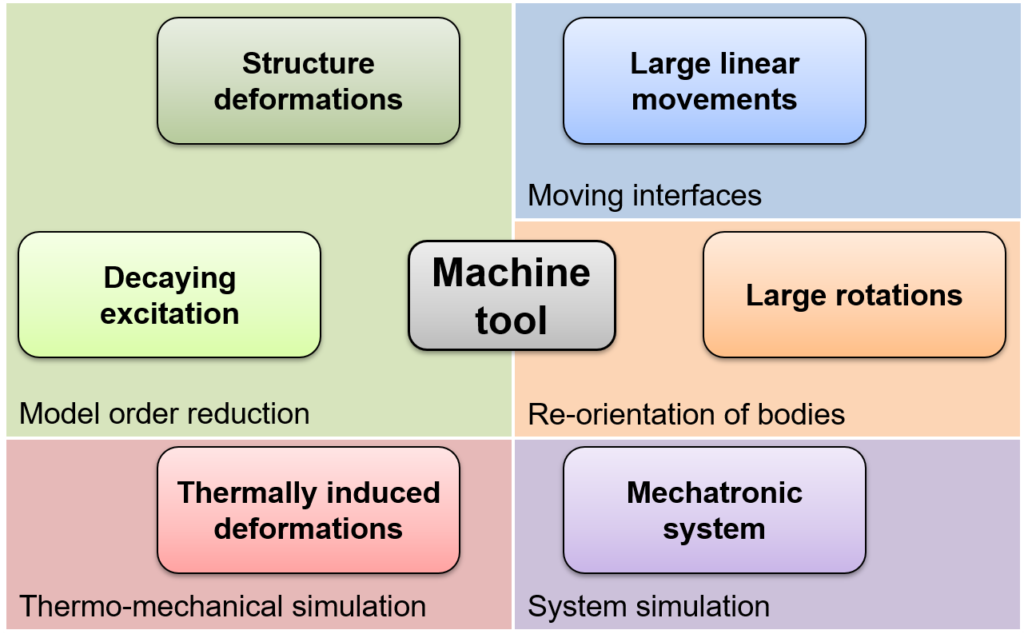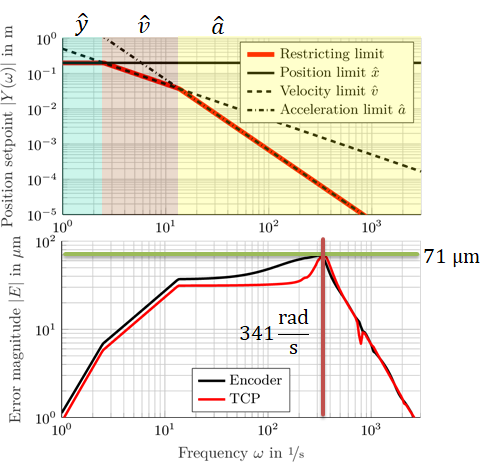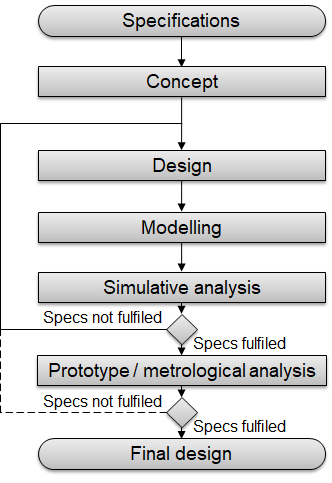How can simulation help the design process of your new machine tool? How can you integrate simulation tools with a reasonable effort in your development process? This blog post will shed some light on the use of virtual prototypes in the machine tool design.
You have built a new machine prototype and the day to turn on the main switch has arrived. You are hopeful that this new prototype will reach all the design targets, outperforming all your previous machine tool models as well as your competitor’s. It is time to test your new prototype and perform the first measurements on the machine tool. You find yourself in an exciting moment. The next hours are crucial. The success of the new machine tool model – or even of your company – depends on the results of the measurements that will be conducted in the next hours or days.
Does that story sound familiar? How secure do you feel on the day of commissioning? Wouldn’t it be good to have predicted in advance if your machine tool concept can achieve the design specifications?
Predict the performance using simulation
When it comes to prediction before even building a prototype, the natural consequence is that models have to be used. But what does it mean to model and predict complex systems like machine tools in order to predict their performance? Let’s break down the crucial points that you should consider if you want to use simulation in the design process.
1. Model the entire machine

A key for successful simulation is that the machine tool has to be considered as a whole system. It is not sufficient to look at the components separately. You can’t determine the bandwidth of a controller from the eigenfrequencies of single components. You also can’t determine displacements at the tool centre point (TCP) caused by the thermal behaviour of single machine parts. This could work only if one single component is responsible for most of the errors. But that would mean that the components aren’t balanced well and that this component is a bottleneck that should be eliminated.
2. Use the right tools
Building an accurate model of the entire machine poses a major challenge. Special attention should be paid to the tools in use. A tool for successful simulation should minimise the effort required for modelling and maximise the flexibility of use as well as the accuracy.
- Accurate, comprehensive models
Obviously, inaccurate models lead to inaccurate prediction of the performance and could be misleading. The model should cover all important effects of a machine, such as static deformation of components, axis position dependency, dynamic properties, controllers, thermo-dynamic and thermo-mechanical behaviour. This poses challenging requirements on simulation software – and this is what we actually developed MORe for. - Efficient modelling
What are the modelling steps required? It is about reducing manual work as far as possible. You should never have to repeat manual tasks. - Efficient calculation
Result generation shouldn’t take hours or even days or weeks. You need a tool that allows to test new ideas and effects quickly, or even to optimise parameters. - Efficient evaluation
Generating raw results is only the starting point. Postprocessing the results is crucial. What are the performance criteria? How to identify the bottleneck?

3. Start early, develop the right methods, and gain confidence
Introducing simulation tools in your design process requires an effort, but it pays off. It is important to introduce these tools progressively, in a ramp-up phase. At an early stage, your team should identify what are the most critical questions that a simulation tool can tackle and focus on these topics. It is relevant to elaborate a plan about how you can use the simulation tools to answer the most relevant questions with the available resources. In the development process, simulation should then not be rocket science, but only clearly structured work that helps you to drive your innovation forward. Be prepared for it!

4. Seamlessly integrate simulation in your development process

In order to apply simulation most effectively during the development of new products, it should be well integrated in the development process. Trying to do some simulation as a side job in the development process usually ends up with results coming too late to have any meaningful impact. If you introduce simulation too late in the design process, it becomes at most a diagnostic tool to identify what went wrong. However, this is not enough to strengthen the innovative power.
5. Free enough resources, it will pay off later
In order to avoid simulation to be the bottleneck in the development process, make sure to free enough resources for modelling and simulation tasks. It seems expensive at a first glance, however, it’s worth it. The success of the product may be at stake!
We know that it isn’t easy to get the personnel resources required, especially if you don’t develop a new product every month. This is why we offer very flexible services. From selling our software MORe to taking over your whole simulation task. We can support you at different levels.
6. Review and improve

Once you have your simulation process in place, it is time to improve. Validate models with measurements as soon as they are available in order to see if you master all components of simulation. Improve evaluation methods, and rethink how simulation could be applied even more efficiently. In this way you can continuously improve models, your products, and finally your business figures.
Simulation in the design as a driver of innovation
After a thoughtful implementation of simulation in the design process, when the right tools are available and you know how to use them most effectively, nothing stops you from going new ways. Be creative and test new solutions at low risk. Detect and eliminate bottlenecks and design well-balanced machines that precisely meet the requirements at the lowest possible production cost. Be the driver of innovation!
Our commitment
Throughout our long history of machine tool simulation, reaching back almost 20 years, we at inspire AG dealt with time-consuming modelling and simulation, using and developing a multitude of different software tools and methods. Many PhD students devoted their work to versatile aspects of simulation, such as
system and control loop simulation,
rigid multibody simulation,
finite element simulation,
thermo-mechanical simulation,
model order reduction, and
flexible multibody simulation.
Since inspire AG is a research institution, we see it as our obligation to face the challenges and develop solutions to problems around simulation. However, an average small or medium-sized enterprise (SME) likely can’t afford this.
That is why we, the MORe team, are devoted to support you getting the most out of your development process by providing the right simulation tools, methods, and services.
Take-home
This post shows that simulation is key to test innovative solutions at a low-cost. In this post, we argue that integrating these tools early in your workflow will boost your innovation power. We show that MORe is the right partner to make this shift in your development a reality.
We believe that every company can use simulation in the design process beneficially, no matter if small or big!

